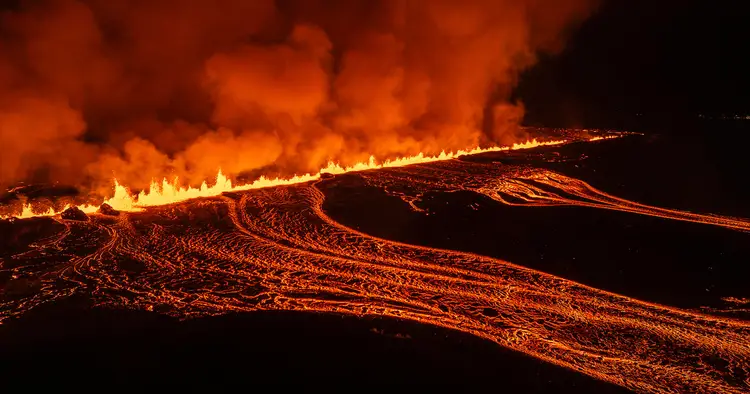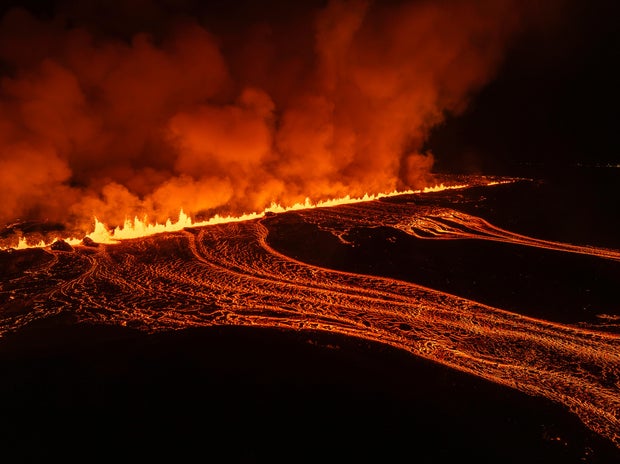Iceland volcano flares up in 7th eruption in a year, Grindavík evacuates residents

Late Wednesday night, a volcano on the Reykjanes peninsula in Iceland erupted once more, making it the seventh time the area has experienced an eruption in the past year.

Just before midnight local time, lava erupted from a fissure in the ground in an area experiencing increased volcanic activity. The eruption was sudden and caused a flow of molten rock to move towards the Blue Lagoon, Iceland's iconic tourist destination. This popular geothermal spa, located in a lava field near the town of Grindavík, attracts almost a million visitors annually.
The Blue Lagoon had to clear out visitors, according to reports from Iceland's national broadcaster RÚV. Footage shared by the broadcaster showed some people dangerously close to the molten lava, seemingly trying to film the eruption with their phones. Emergency teams quickly moved them away to ensure their safety as the lava spread further, engulfing part of the parking lot next to the Blue Lagoon and threatening a vital pipeline that supplies hot water from the Svartsengi geothermal power plant to the spa and surrounding area.
Impressive aerial shots shared by RÚV showcased the scale of the eruption. The video captures glowing magma covering the landscape, while dense smoke billows upwards into the sky.
On Wednesday, around 50 homes were evacuated in Grindavík, a small fishing community located on Iceland's southern peninsula, as stated by the Civil Protection Agency. The agency mentioned that it wasn't clear which volcano was currently erupting, but indicated that the lava was coming from a region where volcanic activity has been observed. Grindavík is situated approximately 30 miles south of Reykjavík, the capital city of Iceland. Officials have not reported any problems in the capital related to the eruption.
On Thursday, officials reported that volcanic activity was still taking place, as seismic sensors showed that magma had covered an area of at least 7 square kilometers, which is just under 4.5 square miles. The Icelandic Meteorological Office noted that the Njarðvík pipeline remained operational beneath the magma. At the time of the latest update, the magma had moved across the road into Grindavík, but it appeared that the eruption had reached its highest intensity and the fissure it came from had become shorter, based on measurements from the National Police Commissioner's special forces unit.
According to the office, seismic activity in the region led to ground fissures and activated the volcano. Iceland is located on a divide between two tectonic plates, making it susceptible to earthquakes and volcanic activity. This geological situation has caused disturbances in various parts of the country and has forced some residents to relocate in recent years.
The Reykjanes peninsula in Iceland has witnessed its seventh volcanic eruption since December 2023, following several smaller eruptions during the summer. Authorities noted that this latest eruption was not as intense as the previous one in August, which caused several ground cracks and triggered a 4.1-magnitude earthquake. That August event occurred only two months after a prolonged eruption that released lava for over three weeks.
At that time, a local police chief informed Icelandic news outlets that the majority of Grindavík’s 4,000 residents had left their homes the previous November due to increasing volcanic activity. Although a few had come back to the town for short visits, most were reluctant to spend the night there, according to the police chief. The residents who did return were safely evacuated.
Prior to the eruption at Mount Fagradalsfjall in March 2021, the Reykjanes peninsula had been free of volcanic activity for about 800 years. Since that event, seismologists have been closely monitoring the revival of a previously inactive fault line that lies beneath the area.
Emily Mae Czachor is a journalist and news editor at CBSNews.com. She specializes in covering urgent news stories, particularly related to crime and severe weather. In the past, Emily Mae has contributed to various publications, such as the Los Angeles Times, BuzzFeed, and Newsweek.













































